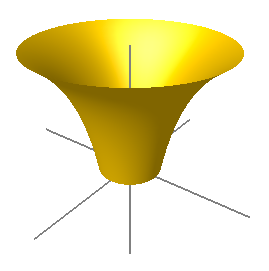- Date for hour exam 1 could move as much as 1 week early
- Test will be limits, limit definition of derivative, basic differentiation rules, product & quotient, trig derivatives
- Moving a whole week is probably extreme, but some move (e.g., to Tuesday, Oct. 7) might be good
- (Mostly) up to you
- “Introduction to R” handout (thanks to Prof. Feissner in Bio)
- A joke: A mathematican walks into a bar and orders a pint of beer. Just as the bartender is about to pour it another mathematician comes in and orders a half pint of beer. Then another mathematician comes in and orders a quarter pint, a fourth comes in and orders an eighth of a pint, and so forth. Finally, in frustration, the bartender shouts at the by now huge crowd of mathematicians “you mathematicians just don’t know your limits!” and hands the whole group 2 pints.
- Questions: What’s the reference to limits about, and why 2 pints?
- Answers: If you add up all the beers ordered by the first mathematician (1 pint), the first two (1 + 1/2 = 1 1/2 pints), the first three (1 + 1/2 + 1/4 = 1 3/4), and so forth, the limit that the sums approach is 2. The reference to not knowing limits is a play on the stereotypical bartender dealing with drunk customers who “don’t know their limits.”
- Antiderivatives

- Normals (perpendiculars) to curves
- Relevant to calculating effects of lighting in computer graphics


- How light reflects off surface depends on the angle at which it arrives relative to normal

- Suppose profile of surface is defined by the equation y = √x - 1. Calculate slope of normal and/or equation for it as a function of x
- Strategy
- Take derivative of √x - 1
- = 1/(2√x) = 0.5 x-1/2
- Plug in x (e.g., 4) to find slope, m
- Slope of perpendicular = -1/m
- General slope of normal = -2√x
- For perpendicular line, use y = mx + b at x = c
- i.e., y = -2√c x + b
- Line of slope m through point (x1, y1) is (y - y1) = m(x - x1)
- Use y = √x - 1 to calculate y
- (y - √c + 1) = -2√x(x - c)
- Take derivative of √x - 1
- Relevant to calculating effects of lighting in computer graphics
- Second half of section 3.3
- Product and quotient rules with proofs
- d( fg ) / dx = f dg/dx + g df/dx
- or df/dx g + dg/dx f
- For example, f(x) = x2 + x
- g(x) = 7x - 9
- d(fg)/dx = (2x+1)(7x-9) + 7(x2 + x)
- d( f/g ) / dx = ( g df/dx - f dg/dx ) / g2
- For example, f(x) = x2 + x
- g(x) = 7x - 9
- d( f/g )/dx
- =( (7x-9)(2x+1) - (x2+x)7 ) / (7x-9)2
- For example, f(x) = x2 + x
- Higher order (2nd, 3rd, etc) derivatives
- Continue down to derivative = 0
- Examples
- d( (x2 + 2)(x - 1) )/dx
- = 1(x2 + 2) + (x - 1)2x
- = x2 + 2 + 2x2 - 2x
- = 3x2 - 2x + 2
- d( (x3 - 4x2 + 2)( 1 + 1/x) )/dx
- = d( cp ) / dx
- = p dc/dx + c dp/dx
- = [( 1 + 1/x)(3x2 - 8x)] + [(x3 - 4x2 + 2)(-x-2)]
- = [ 3x2 - 8x + 3x - 8 ] + [-x + 4 - 2x-2 ]
- = 3x2 - 6x - 2x-2 - 4
- d( x3 / x ) / dx (should be 2x)
- = ( 3x2 x - x3 ) / x2
- = 2x3 / x2
- = 2x
- d( (x2 + 2)(x - 1) )/dx
- Derivatives of trigonometric functions
- Section 3.5